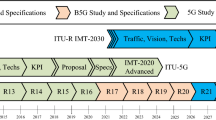Abstract
We propose a multi-hop transmission protocol suitable for the reverse link of cellular systems. The proposed protocol, referred to as cooperative multiplexing with partial relaying (CM-PR), is based on relaying of partial information bits followed by cooperative multiplexing. The CM-PR protocol provides path loss reduction and spatial diversity gain without any loss in the spectral efficiency, in contrast to the conventional decode-and-forward protocol or its variants that cause bandwidth expansion to attain such benefits. Simulation results confirm that the CM-PR protocol significantly outperforms the direct transmission in terms of the bit error rate, especially when a relay is close to the source.
Similar content being viewed by others
References
Le L., Hossain E. (2007) Multihop cellular networks: potential gains, research challenges, and a resource allocation framework. IEEE Communications Magazine 45(9): 66–73
Third Generation Partnership Project (3GPP). (2009). Further advancements for E-UTRA physical layer aspects (Release 9). 3GPP TR 36.814, V1.5.0.
Nabar R. U., Bölcskei H., Kneubühner F. W. (2004) Fading relay channels: Performance limits and space-time signal design. IEEE Journal on Selected Areas in Communications 22(8): 1099–1109
Laneman J. N., Tse D. N. C., Wornell G. W. (2004) Cooperative diversity in wireless networks: Efficient protocols and outage behavior. IEEE Transactions on Information Theory 50(12): 3062–3080
Nosratinia A., Hedayat A. (2004) Cooperative communication in wireless networks. IEEE Communications Magazine 42(10): 74–80
Yuksel M., Erkip E. (2004) Broadcast strategies for the fading relay channel. Proceeding of IEEE Military Communications Conference 2: 1060–1065
Chen D., Laneman J. N. (2006) Modulation and demodulation for cooperative diversity in wireless systems. IEEE Transactions on Wireless Communications 5(7): 1785–1794
Prasad, N., & Varanasi, M. K. (2004). Diversity and multiplexing tradeoff bounds for cooperative diversity protocols. In Proceeding of IEEE International Symposium on Information Theory, Chicago, IL, USA, p. 271.
Shin O.-S., Chan A., Kung H. T., Tarokh V. (2007) Design of an OFDM cooperative space-time diversity system. IEEE Transactions on Vehicular Technology 56(7): 2203–2215
Proakis J. G. (2008) Digital Communications (5th ed.). McGraw-Hill, New York
Paulraj A., Nabar R., Gore D. (2003) Introduction to Space-Time Wireless Communications. Cambridge University Press, UK
Author information
Authors and Affiliations
Corresponding author
Rights and permissions
About this article
Cite this article
Shin, OS., Lee, JH. Efficient Partial Relaying Protocol for Wireless Multi-Hop Transmission. Wireless Pers Commun 65, 443–453 (2012). https://doi.org/10.1007/s11277-011-0266-y
Published:
Issue Date:
DOI: https://doi.org/10.1007/s11277-011-0266-y




